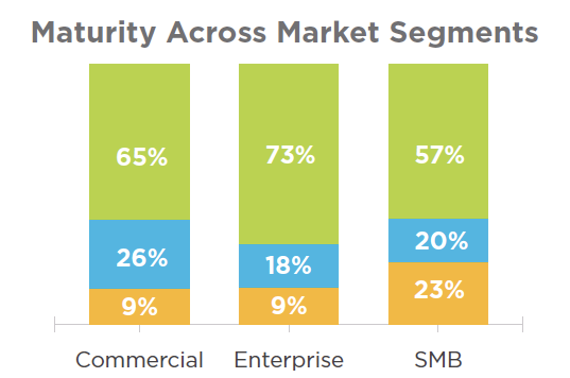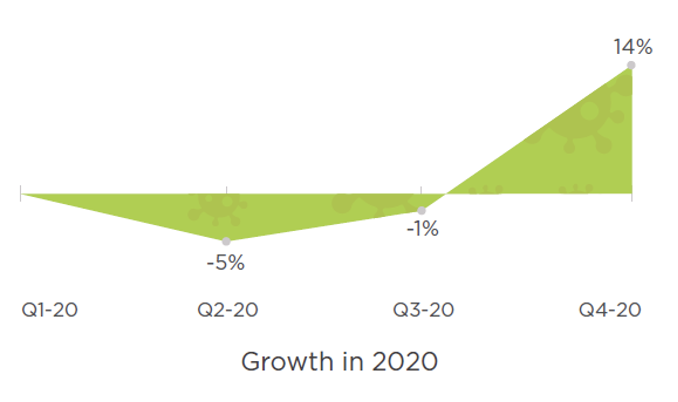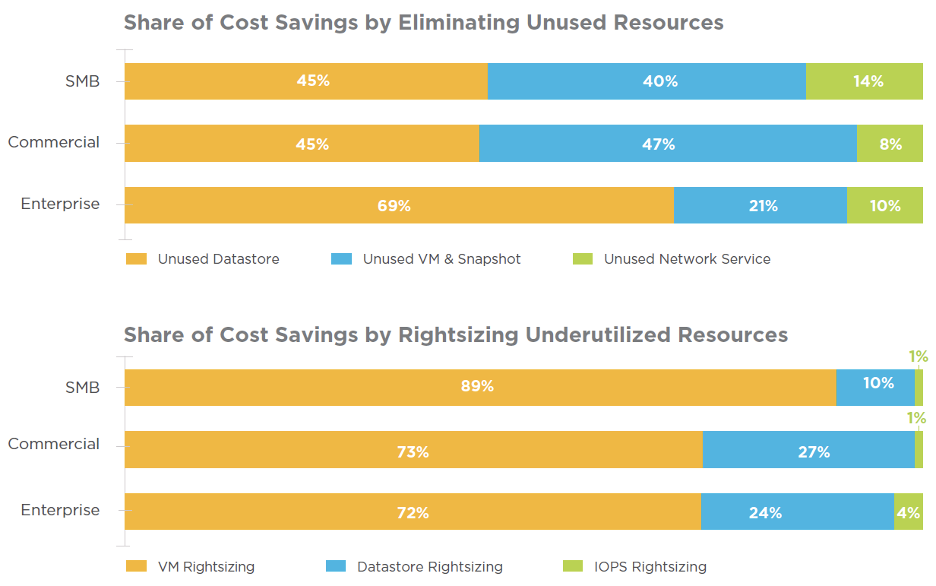Across the world, 2020 was a year like no other. As the pandemic shuttered businesses and halted production in many industries, companies had to adapt quickly or risk closing down for good.
According to the Nutanix Cloud Usage Report 2021, a study based on real-world data gathered from Nutanix customers, many companies survived by turning to public cloud services to support increasingly remote workforces. In 2020, the number of cloud “experts” – those using more than 30 cloud services and having advanced cloud skills – nearly doubled in the small and midsized business (SMB) and commercial market segments. It also increased by nearly 15% among enterprises.

The majority of businesses across all market segments are cloud experts.
At the same time, however, some companies took advantage of the cloud’s elasticity – the ability to grow or shrink resource usage dynamically and pay only for what they consume – to manage spending during tough times.
Not All Industries Pivoted the Same Way
“Public cloud usage grew somewhere between 25% to 45% over the calendar year of 2020,” said Sahil Bansal, author of the report and Senior Product Marketing Manager for Nutanix Beam, a multicloud cost management tool. “But the growth pattern was very different from industry to industry.”
For example, public cloud spending dropped sharply among manufacturing and retail companies in the first half of 2020 as they went into cost-cutting mode. Then cloud spending rebounded strongly for these businesses in the second half of the year.
The agile nature of the public cloud was what allowed companies in these industries to “turn on and off the tap” as needed, said Bansal.
“They could pull back on their cloud spend, on their cloud consumption. That's how they initially conserved money,” he said.
Some industries weren’t affected as strongly as manufacturing and retail. Technology, media and telecom (TMT) companies, for example, were able to pivot very quickly to a remote-first work model and keep operations running close to normal. The report states that this industry continues to be “one of the strongest drivers of overall cloud spending, with technology-driven businesses being very cloud-friendly.”
TMT companies “saw an immediate spike starting in the first two quarters of 2020, because there was no pullback in their business,” said Bansal. “In fact, they were able to work more efficiently while going remote. So their cloud spend actually increased quite significantly.”
Cloud Spending in Manufacturing and Retail

Manufacturer and retailer cloud budgets took a hit in the first half of 2020.
Cloud Spending in Technology, Media and Telecom

TMT cloud spending increased throughout the year.
3 Steps to Reducing Public Cloud Costs
As the pandemic affected businesses around the world, many did what they could to curb spending. The report referenced a recent article by venture capital firm Andreessen Horowitz, in which the authors had analyzed cloud costs over time and advised businesses to implement smart cost control and optimization policies to avoid overspending.
With that analysis in mind, the Cloud Usage Report examined what Nutanix customers were doing to conserve public cloud costs. It found that there were three primary strategies enabling organizations to save up to 15% on their cloud spend: deleting old or unused resources, right-sizing data stores, and right-sizing virtual machines (VMs).
How Companies Are Conserving Cloud Costs

Eliminating unused resources and right-sizing underutilized ones optimize cloud spend.
All three approaches require real-time monitoring of resource consumption and the elimination of unused cloud resources. But the task is well worth it, said Bansal, who added that savings can be even greater with additional effort.
“If you are implementing very strong cost governance policies… you can lower your spending by up to 35%,” said Bansal. He said companies can further lower their cloud services bill using consumption optimization and automation.
According to Bansal, analyzing how much cloud capacity they’ll need over a period of several years and switching from a pay-as-you-go plan to a reservation-based plan enables companies to save another 15%. By automating shutoff times for resources that don’t need to be used, say, in the evenings or on weekends, companies can avoid overpaying for them and potentially save another 5%, he said.
What’s Next: Hybrid Cloud Still Key
Bansal told The Forecast that he expects continued public cloud spend growth and greater adoption of containers and serverless computing.
He also stressed that hybrid multicloud models will remain front and center because not all workloads are suitable for the public cloud.
“Hybrid multicloud” refers to a mix of private cloud(s) and more than one public cloud platform, often necessary because each public cloud provider has its own specialties, Bansal explained.
He pointed the Enterprise Cloud Index 2020, a global study of 3400 cross-industry IT professionals commissioned by Nutanix, showing 86% of respondents consider hybrid cloud the ideal operating model.
“People want the flexibility of being able to use any environment, on-premises or public cloud, and they want … to migrate across those environments easily without being tied to the underlying platform,” Bansal said.
Lessons to be Learned
Bansal said he hopes readers can take advantage of the Cloud Usage Report in two ways. First, he said it’s a good resource for companies that might just be entering the world of public cloud.
“The report analyzes the top services people use in each category … compute, storage, databases, networking, analytics and security,” he said. “For someone relatively new to public cloud, it can be pretty daunting when presented with a buffet of options to try and figure out.”
He hopes the report can give the uninitiated a view of the current public cloud landscape and insight into what their peers and competitors are using as a starting point.
Finally, Bansal hopes the report helps people understand that “public cloud has a lot of benefits, but you need to put in the time and effort to build cost governance policies.” These exercises are needed to optimize cloud usage—by running workloads in the cloud and service best suited to them—and to control spending over time, he said.
Editor’s note: See Forecast coverage of past Cloud Usage Reports: Cloud Usage Report 2019: Healthcare is a Late Adopter of Cloud and Cloud Usage Report 2019 Shows Shift in How Companies Consume Cloud Services.
Erin Poulson is a contributing writer who specializes in IT and business topics.
© 2021 Nutanix, Inc. All rights reserved. For additional legal information, please go here.





